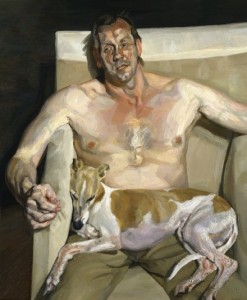Composition dogs: part 3
November 6, 2014
Dogs and owners: Spaces between
Above: “Eli and David”, by Lucian Freud, 2005-6. A portrait of David Dawson (Freud’s assistant and friend) with his whippet.
I find “Eli and David” remarkable both as a powerful composition and for the way in which it demonstrates a key aspect of human-canine relationships. This man, painted with all his human flaws and concerns, comes under our close scrutiny, but the dog accepts and trusts him regardless. As in several of Freud’s canvases, the dog does not care about the figure’s semi-nakedness or awkward pose. Squashed together within the armchair, dog and owner appear to accept one another’s close presence without criticism or complaint.
Compositionally, this painting has a wonderful abstract quality. It is broken into major sections by the horizontal edges of chair back and dog’s back, with the black background forming a strong inverted “L” shape. The side of the chair forms a vertical barrier against which the dog’s head is squashed, adding a feel of dynamic tension to the whole image. Negative shapes between dog, chair and man echo one another pleasingly.
Above: Mary Cassatt “Little girl in a blue armchair”, 1878, oil on canvas
Similarly, the girl sprawled in the chair in Cassatt’s image appears uninhibited in the presence of her canine companion. Both girl and dog are dwarfed in this room of outsize armchairs and this image could represent the strange childhood sensation of feeling out of place. Apparently unaware of the painter, the girl looks to the dog for companionship though, in this case, there is a quite a void of grey carpet between them. Painted as a rounded, enclosed, intensely dark oval, this terrier forms a strong enough shape to counterbalance the image.
Above: Piero di Cosimo “A Satyr mourning over a Nymph”, c1495, oil on poplar, 65.4 x 184.2cm
In contrast, the final image in this series is otherworldly. The fallen female figure is the nymph, Procris, who in Greek mythology was accidentally shot and killed by her husband, Cephalus. The presence of both satyr and dog is mysterious. A satyr was not present in the original story, and the identity of the dog is unclear.
Between them both, the satyr and foreground dog create a compositional arch above the dead nymph. Look at the curves of their backs clear against the sky. Though the husband (the only human in the story) seems to have disappeared, this arch suggests care, protection and fidelity. The satyr shows compassion and tenderness, but the dog gazes unflinchingly at the strange scene. As probably occurs over and again in real life, this dog has been a silent witness to some strange human drama.


